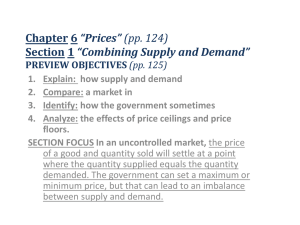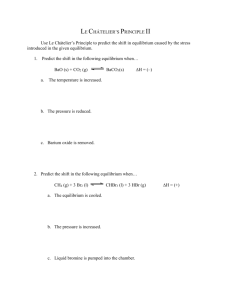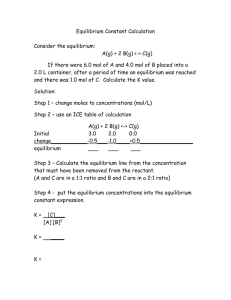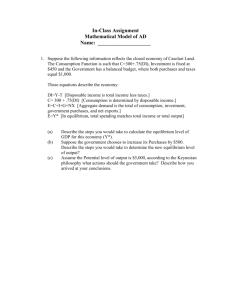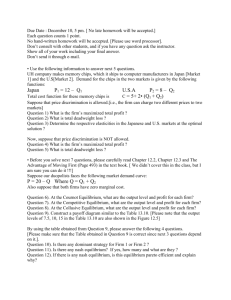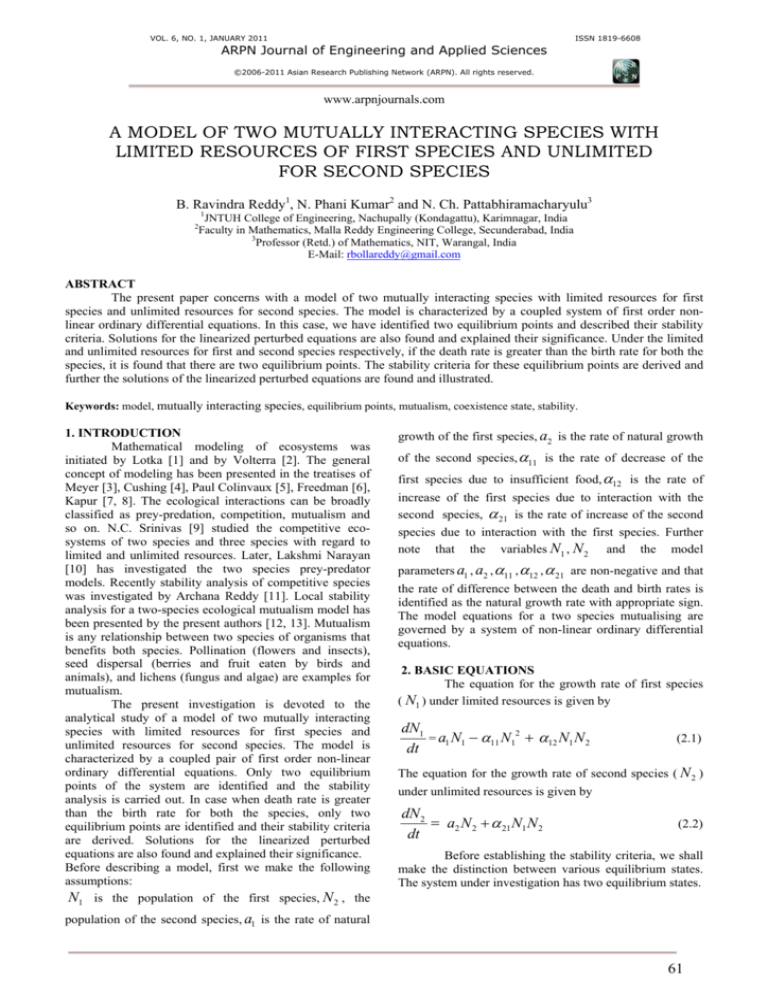
VOL. 6, NO. 1, JANUARY 2011
ISSN 1819-6608
ARPN Journal of Engineering and Applied Sciences
©2006-2011 Asian Research Publishing Network (ARPN). All rights reserved.
www.arpnjournals.com
A MODEL OF TWO MUTUALLY INTERACTING SPECIES WITH
LIMITED RESOURCES OF FIRST SPECIES AND UNLIMITED
FOR SECOND SPECIES
B. Ravindra Reddy1, N. Phani Kumar2 and N. Ch. Pattabhiramacharyulu3
1
JNTUH College of Engineering, Nachupally (Kondagattu), Karimnagar, India
Faculty in Mathematics, Malla Reddy Engineering College, Secunderabad, India
3
Professor (Retd.) of Mathematics, NIT, Warangal, India
E-Mail: rbollareddy@gmail.com
2
ABSTRACT
The present paper concerns with a model of two mutually interacting species with limited resources for first
species and unlimited resources for second species. The model is characterized by a coupled system of first order nonlinear ordinary differential equations. In this case, we have identified two equilibrium points and described their stability
criteria. Solutions for the linearized perturbed equations are also found and explained their significance. Under the limited
and unlimited resources for first and second species respectively, if the death rate is greater than the birth rate for both the
species, it is found that there are two equilibrium points. The stability criteria for these equilibrium points are derived and
further the solutions of the linearized perturbed equations are found and illustrated.
Keywords: model, mutually interacting species, equilibrium points, mutualism, coexistence state, stability.
1. INTRODUCTION
Mathematical modeling of ecosystems was
initiated by Lotka [1] and by Volterra [2]. The general
concept of modeling has been presented in the treatises of
Meyer [3], Cushing [4], Paul Colinvaux [5], Freedman [6],
Kapur [7, 8]. The ecological interactions can be broadly
classified as prey-predation, competition, mutualism and
so on. N.C. Srinivas [9] studied the competitive ecosystems of two species and three species with regard to
limited and unlimited resources. Later, Lakshmi Narayan
[10] has investigated the two species prey-predator
models. Recently stability analysis of competitive species
was investigated by Archana Reddy [11]. Local stability
analysis for a two-species ecological mutualism model has
been presented by the present authors [12, 13]. Mutualism
is any relationship between two species of organisms that
benefits both species. Pollination (flowers and insects),
seed dispersal (berries and fruit eaten by birds and
animals), and lichens (fungus and algae) are examples for
mutualism.
The present investigation is devoted to the
analytical study of a model of two mutually interacting
species with limited resources for first species and
unlimited resources for second species. The model is
characterized by a coupled pair of first order non-linear
ordinary differential equations. Only two equilibrium
points of the system are identified and the stability
analysis is carried out. In case when death rate is greater
than the birth rate for both the species, only two
equilibrium points are identified and their stability criteria
are derived. Solutions for the linearized perturbed
equations are also found and explained their significance.
Before describing a model, first we make the following
assumptions:
N1 is the population of the first species, N 2 , the
growth of the first species, a2 is the rate of natural growth
of the second species, α11 is the rate of decrease of the
first species due to insufficient food, α12 is the rate of
increase of the first species due to interaction with the
second species, α 21 is the rate of increase of the second
species due to interaction with the first species. Further
note that the variables N1 , N 2 and the model
parameters a1 , a2 , α11 , α12 , α 21 are non-negative and that
the rate of difference between the death and birth rates is
identified as the natural growth rate with appropriate sign.
The model equations for a two species mutualising are
governed by a system of non-linear ordinary differential
equations.
2. BASIC EQUATIONS
The equation for the growth rate of first species
( N1 ) under limited resources is given by
dN1
2
= a1 N1 − α11 N1 + α12 N1 N 2
dt
(2.1)
The equation for the growth rate of second species ( N 2 )
under unlimited resources is given by
dN 2
= a2 N 2 + α 21 N1 N 2
dt
(2.2)
Before establishing the stability criteria, we shall
make the distinction between various equilibrium states.
The system under investigation has two equilibrium states.
population of the second species, a1 is the rate of natural
61
VOL. 6, NO. 1, JANUARY 2011
ISSN 1819-6608
ARPN Journal of Engineering and Applied Sciences
©2006-2011 Asian Research Publishing Network (ARPN). All rights reserved.
www.arpnjournals.com
I. N 1
= 0; N 2 = 0 , the state in which both the species
are washed out.
II. N 1 =
species
a1
α11
( N1 )
; N 2 = 0 , the state in which the first
survives and the second species (N2) is
washed out.
Now we study the stability of these equilibrium
states. Let us write
(u1 ,u2 ) is a small perturbation over the
equilibrium state N = ( N1 , N 2 ) .
The basic equations (2.1), (2.2) are linearized to
obtain the equations for the perturbed state,
dU
= AU
dt
(2.3)
Where
⎡ a − 2α11 N 1 + α12 N 2
A=⎢ 1
⎢⎣α 21 N 2
α12 N 1 ⎤
⎥
a2 + α 21 N 1 ⎥⎦
(2.4)
The characteristic equation for the system is
det [ A − λ I ] = 0
Equilibrium state I (fully washed out state):
To discuss the stability of equilibrium
state N 1
= 0 ; N 2 = 0 , we consider small perturbations
u1 (t ) and u2 (t ) from the steady state, i.e. we write
N1 = N 1 + u1 (t ) ,
(2.6)
N 2 = N 2 + u2 (t ) .
(2.7)
Substituting (2.6) and (2.7) in (2.1) and (2.2), we get
du2
= a2u2 + α 21u1u2
dt
equilibrium state is unstable.
The solutions of equations (2.8) and (2.9) are
a1t
(2.10)
u2 = u20 e
a2 t
(2.11)
Where u10 ,
u20 are the initial values of u1 and u2 . The
solution curves are illustrated in Figures 1 to 4
Case 1: a1 < a2 and u10 < u20 i.e. the second species
dominates the first species in the natural growth rate as
well as in its initial population strength.
In this case, the second species continues out
numbering the first species as shown in Figure-1.
Case 2: a1 < a2 and u10 > u20 i.e. the second species
dominates the first species in the natural growth rate but
its initial strength is less than that of first species.
In this case, the first species out numbers the
second species till the time,
t = t* =
ln {u10 / u20 }
(a2 -a1 )
after that the second species out numbers the first species.
Case 3: a1 > a2 and u10 < u20 i.e. the first species
dominates the second species in the natural growth rate but
its initial strength is less than that of second species.
In this case, the second species out numbers the
first species till the time,
t = t* =
ln {u10 / u20 }
(a2 -a1 )
after that the first species out numbers the second species.
Case 4: a1 > a2 and u10 > u20 i.e. the first species
⎡ u1 ⎤
⎢ ⎥
⎣ u10 ⎦
After linearization, we get
and
a2 are both positive. Hence the
dominates the second species in the natural growth as well
as in its initial population strength.
In this case, the first species continues out
numbering the second species as shown in Figure-4.
Further the trajectories in the (u1 ,u2 ) plane are given by
du1
= a1u1 − α11u12 + α12u1u2
dt
du1
= a1u1
dt
whose roots a1 ,
(2.5)
The equilibrium state is stable, if both the roots of
the equation (2.5) are negative in case they are real or have
negative real parts in case they are complex.
(2.9)
The characteristic equation is
(λ - a1 )(λ - a2 ) =0,
u1 = u10 e
N = (N1, N2) = N + U
Where U =
du2
= a2 u2
dt
(2.8)
a2
⎡u ⎤
=⎢ 2 ⎥
⎣ u20 ⎦
a1
and these are illustrated in Figure-5.
Equilibrium state II ( N1 exists while
N 2 is washed out):
62
VOL. 6, NO. 1, JANUARY 2011
ISSN 1819-6608
ARPN Journal of Engineering and Applied Sciences
©2006-2011 Asian Research Publishing Network (ARPN). All rights reserved.
www.arpnjournals.com
We have
N1 =
a1
α11
As such the state is unstable.
CASE 2: u10 > u20 i.e. the initial strength of first species
;N2 = 0
is greater than that of the second species.
Initially the first species out numbers the second
species and this continues up to the time instant,
Substituting (2.6) and (2.7) in (2.1) and (2.2), we get
du1
aα u
= − a1u1 − α11u12 + α12u1u2 + 1 12 2
α11
dt
t = t* =
du2
aα u
= a2u2 + α 21u1u2 + 1 21 2
α11
dt
du1
aα u
= − a1u1 + 1 12 2
α11
dt
(2.12)
du2 ⎡
aα ⎤
= ⎢ a2 + 1 21 ⎥ u 2
dt ⎣
α11 ⎦
(2.13)
The characteristic equation is
α11
α11
λ1 = −a1
which is negative
which
is
positive.
Hence
the
1 ⎡
-a t
u a α e λ2t + {u10 γ - u20 a1α12 }e 1 ⎤⎥ (2.14)
1
⎦
γ ⎣⎢ 20 1 12
1
u2 =u20 eλ2t
(2.15)
Where
λ2 = a2 +
a1α 21
α11
;
γ = a2α11 + a1[α11 + α 21 ]
1
The solution curves are illustrated in Figures 6
and 7
CASE 1:
u10 < u20 i.e. the second species dominates the
first species in its initial strength.
We notice that the second species is going away
from the equilibrium point while the first species would
become extinct at the instant
t1* =
q1
− p1u2
p =
a1α12
;
a1α 21 + a2α11
q =
-a1α11
a1α 21 + a2α11
1
equilibrium state is unstable.
The trajectories are given by
u1 =
(q1 − 1)u1 = c u2
1
while the other root is
a1α 21
⎡ u α a −u γ ⎤
1
ln ⎢⎢ 20 u12α1 a10 1 ⎥⎥
20 12 1
⎦
(λ2 + a1 ) ⎣
Where
]}
One root of this equation is
λ2 = a2 +
t1* =
As such the state is unstable. Also the trajectories in the
(u1 ,u2 ) plane are given by
and
a1α 21
⎧ u10α11 (λ2 + a1 ) − u20 a 1α12 ⎫
⎨
⎬
⎩ u20 [α11 (λ2 + a1 ) − a1α12 ] ⎭
there after the second species out numbers the first
species. And also the second species is noted to be going
away from the equilibrium point while the first species
would become extinct at the instant
After linearization, we get
(λ +a1 ) {λ -[a2 +
1
ln
λ2 + a1
⎡ u α a −u γ ⎤
1
ln ⎢⎢ 20 u12α1 a10 1 ⎥⎥
20 12 1
⎦
(λ2 + a1 ) ⎣
and c is an arbitrary constant.
The solution curves are illustrated in Figure-8.
3. THE DEATH RATE IS GREATER THAN THE
BIRTH RATE FOR BOTH THE SPECIES
The basic equations governing the system are
dN1
2
= − a1 N1 − α11 N1 + α12 N1 N 2
dt
(3.1)
dN 2
= −a2 N 2 + α 21 N1 N 2
dt
(3.2)
Here we come across two equilibrium states:
I.
N 1 = 0; N 2 = 0
(3.3)
The state in which both the species are washed out
II. N 1 =
a2
α 21
;N2 =
a1α 21 + a2α11
α12α 21
.
(3.4)
The state in which both the species co-exist.
Equilibrium state I (fully washed out state):
63
VOL. 6, NO. 1, JANUARY 2011
ISSN 1819-6608
ARPN Journal of Engineering and Applied Sciences
©2006-2011 Asian Research Publishing Network (ARPN). All rights reserved.
www.arpnjournals.com
To
discuss
the
stability
of
equilibrium
= 0 ; N 2 = 0 , we consider small perturbations
state N 1
u1 (t ) and u2 (t ) from the steady state, i.e. we write
N1 = N 1 + u1 (t ) ,
(3.5)
N 2 = N 2 + u2 (t ) .
(3.6)
Substituting (3.5) and (3.6) in (3.1) and (3.2), we get
du1
= −a1u1 − α11u12 + α12u1u2
dt
After linearization, we get
du1
= −a1u1
dt
(3.7)
(3.8)
The characteristic equation is
(λ + a1 )(λ + a2 ) =0
The roots of this equation, λ1= −a1 and λ2=
−a2
are both negative. Hence the equilibrium state is stable.
The solutions of equations (3.7) and (3.8) are
u2 = u20 e
Where u10 ,
(3.9)
(3.10)
u20 are the initial values of u1 and u2 . The
solution curves are illustrated in Figures 9 to 12.
CASE 1: a1 > a2 and u10>u20 i.e., the first species
dominates the second species in the natural growth rate as
well as in its initial population strength.
In this case the first species continues out
numbering the second species as shown in Figure-9. It is
evident that both the species converging asymptotically to
the equilibrium point. Hence the equilibrium state is
stable.
CASE 2: a1 > a2 and u10 < u20 i.e., the first species
dominates the second species in the natural growth rate but
its initial strength is less than that of second species.
In this case, initially the second species out
numbers the first species and this continues up to the time,
t = t* =
ln {u10 / u20 }
(a1 -a2 )
u2
approach to the equilibrium
point. Hence the state is stable.
CASE 3: a1 < a2 and u10 < u20 i.e. the second species
dominates the first species in the natural growth rate as
well as in its initial population strength.
In this case the second species always out
numbers the first species. It is evident that both the species
converging asymptotically to the equilibrium point. Hence
the state is stable.
CASE 4: a1 < a2 and u10 > u20 i.e., the second species
t = t* =
ln {u10 / u20 }
(a1 -a2 )
As t → ∞ both
du2
= −a2u2
dt
− a2t
u1 and
after that the second species out numbers the first species.
and
− a1t
As t → ∞ both
dominates the first species in the natural growth rate but
its initial strength is less than that of first species.
In this case, the first species dominates the
second species till the time,
du2
= −a2u2 + α 21u1u2
dt
u1 = u10 e
after that the first species out numbers the second species.
u1 and
u2
approach to the equilibrium
point. Hence the state is stable. Also the trajectories in the
(u1 ,u2 ) plane are given by
⎡ u1 ⎤
⎢ ⎥
⎣ u10 ⎦
− a2
⎡u ⎤
=⎢ 2 ⎥
⎣ u20 ⎦
−a1
Equilibrium state II (coexistence state):
We have
N1 =
a2
α 21
;N2 =
a2α11 + a1α 21
α12α 21
Substituting (3.5) and (3.6) in (3.1) and (3.2), we get
du1
= −α11u12 + α12u1u2 − α11 N 1u1 + α12 N 1 u2
dt
du2
= α 21u1 N 2 + α 21u1u2
dt
After linearization, we get
du1
= −α11 N 1u1 + α12 N 1 u2
dt
(3.11)
and
du2
= α 21u1 N 2
dt
(3.12)
The characteristic equation is
λ 2 + α11 N 1λ −α12α 21 N 1 N 2 = 0
64
VOL. 6, NO. 1, JANUARY 2011
ISSN 1819-6608
ARPN Journal of Engineering and Applied Sciences
©2006-2011 Asian Research Publishing Network (ARPN). All rights reserved.
www.arpnjournals.com
One root of this equation is positive and the other
root is negative. Hence the equilibrium state is unstable.
The trajectories are given by
⎡u λ + u α N ⎤ λ t
u1 = ⎢ 10 1 20 12 1 ⎥ e 1
λ1 − λ2
⎣
⎦
⎡u λ + u α N ⎤ λ t
+ ⎢ 10 2 20 12 1 ⎥ e 2
λ2 − λ1
⎣
⎦
In this case the second species dominates the first
species till the time,
t = t* =
⎡
1
(b -λ )u +(a3 −b1 )u20 ⎤⎥
ln ⎢⎢ 2 1 10
⎥
λ2 − λ1 ⎢⎣ (b2 −λ2 )u10 + (a4 −b1 )u20 ⎥⎦
Where
b1 = α12 N 1 ; b2 = α 21 N 2 ;
a3 = λ1 + α11 N 1 ; a4 = λ2 + α11 N 1
⎡ u (λ + α N ) + u10α 21 N 2 ⎤ λ1 t
u2 = ⎢ 20 1 11 1
+
⎥e
λ1 − λ2
⎣
⎦
⎡ u20 (λ2 + α11 N 1 ) + u10α 21 N 2 ⎤ λ2 t
⎢
⎥ e
λ2 − λ1
⎣
⎦
after that the first species dominates the second species
and grows indefinitely while the second species
asymptotically approaches to the equilibrium point. Hence
the state is unstable. Further the trajectories in the
(u1 ,u2 ) plane are given by
The curves are illustrated in Figures 13 and 14.
Case 1: u10 > u20 i.e. initially the first species dominates
[u2
the second species.
In this case, the first species is noted to be going
away from the equilibrium point while the second species
approaches asymptotically to the equilibrium point. Hence
the state is unstable.
Case 2: u10 < u20 i.e., initially the second species
( a −1)(v1 − v2 )
where
]d =
(u1 − u2 v1 )
(u1 − v2u2 )
av1
av2
v1 and v2 are roots of the quadratic equation
av 2 +bv+c =0
with
a =α 21 N 2 ;
b =α11 N 1 ;
c = − α12 N 1 and d is an arbitrary constant.
dominates the first species.
4. TRAJECTORIES
65
VOL. 6, NO. 1, JANUARY 2011
ISSN 1819-6608
ARPN Journal of Engineering and Applied Sciences
©2006-2011 Asian Research Publishing Network (ARPN). All rights reserved.
www.arpnjournals.com
REFERENCES
[1] Lotka A. j. 1925. Elements of Physical Biology.
Williams and Wilkins, Baltimore.
[2] Volterra V. 1931. Leconssen la theorie mathematique
de la leitte pou lavie, Gauthier - Villars, Paris.
[3] Meyer W.J. 1985. Concepts
Modeling. McGraw - Hill.
of
Mathematical
[11] Archana Reddy. R. 2009. On the stability of some
mathematical models in biosciences-interacting
species. PhD Thesis. JNTU, India.
[12] Ravindra Reddy B., Lakshmi Narayan K. and
Pattabhiramacharyulu N.Ch. 2009. A model of two
mutually interacting species with limited resources for
both the species. International J. of Engg. Research
and Indu. Appls. 2(II): 281-291.
[4] Cushing J. M. 1977. Integro - differential equations
and Delay Models in Population Dynamics. Lecture
Notes in Biomathematics. Vol. 20, Springer - Verlag,
Heidelberg.
[5] Paul Colinvaux. 1986. Ecology. John Wiley and Sons
Inc., New York.
[6] Freedman H. I. 1980. Deterministic Mathematical
Models in Population Ecology. Marcel - Decker, New
York.
[7] Kapur J. N. 1988. Mathematical Modeling. Wiley Eastern.
[8] Kapur J.N. 1985. Mathematical Models in Biology
and Medicine. Affiliated East - West.
[9] Srinivas N.C. 1991. Some Mathematical aspects of
modeling in Bio Medical Sciences. Ph.D Thesis.
Kakatiya University, India.
[10] Lakshmi Narayan K. 2004. A Mathematical study of
Prey-Predator Ecological Models with a partial covers
for the prey and alternative food for the predator.
Ph.D Thesis. J.N.T. University, India.
66


